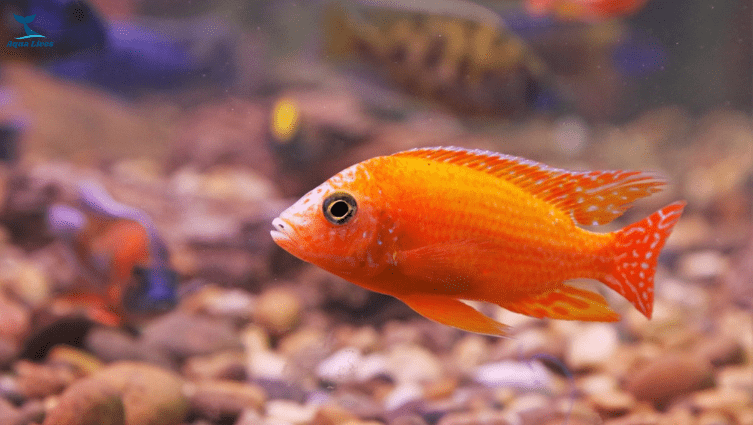Red Zebra Cichlid Mbuna
Red Zebra Cichlid, scientifically known as Metriaclima Estherae, is a popular freshwater fish species originating from Lake Malawi in East Africa. Known for their striking red and blue coloration, these cichlids are prized for their vibrant appearance and engaging behavior. In aquariums, They may appear yellow, not red like in the wild. Also, their zebra stripes might not be very noticeable. Despite their name, they’re lively fish known for their bright yellow color and feisty behavior. This introduction’ll explore their natural habitat, physical characteristics, behavior, tank requirements, diet, and more. Let’s dive into the fascinating world of this fish.
Origin and Habitat of Red Zebra Cichlid
Red Zebra Cichlid (Metriaclima Estherae) originate from Lake Malawi, one of the African Great Lakes located in East Africa. Within Lake Malawi, these cichlids are commonly found along the rocky shores and sandy substrate areas, particularly in the southern regions of the lake. Their natural habitat consists of rocky formations, caves, and sandy bottoms, where they seek shelter and establish territories. Lake Malawi provides a diverse environment with warm, alkaline waters, abundant vegetation, and various species of fish, contributing to the rich biodiversity of this ecosystem.
Diet and Feeding
They are omnivores with diverse dietary needs. In their natural habitat, they primarily feed on small invertebrates, algae, and plant matter. In captivity, they should be offered a varied diet consisting of high-quality pellets and flakes and occasional live or frozen foods such as brine shrimp, bloodworms, and vegetable matter. A balanced diet ensures they receive essential nutrients and helps replicate their natural feeding behaviors. It’s important not to overfeed to prevent obesity and maintain their overall health.
Physical Characteristics
The fish exhibit distinct physical characteristics that make it visually striking and popular among aquarium enthusiasts. These African cichlids typically have an elongated body shape with vibrant coloration, predominantly red or orange, with vertical black stripes running along their bodies. They do not always display prominent black stripes, especially in captivity. Many have a solid orange or red hue without visible stripes. Their fins may also display contrasting colors, adding to their appeal. Additionally, They have large, expressive eyes and a slightly protruding mouth, giving it a unique appearance. Mature males often develop brighter colors and may exhibit a more pronounced body shape compared to females. Their vibrant colors and striking patterns make them a captivating addition to freshwater aquariums.
Breeding Behavior
Breeding behavior in this fish is fascinating to observe, as these fish exhibit intricate courtship rituals and parental care. During the breeding season, males become more vibrant in coloration and display aggressive behavior to establish territory and attract females. Courtship involves elaborate displays, with males showcasing their fins and colors to woo potential mates. Once a pair forms, the female lays eggs on a cleaned substrate, typically a flat rock or surface. They are mouthbrooders, meaning the female typically carries the fertilized eggs and fry in her mouth for protection. Males do not participate in this process beyond fertilization.
Red Zebra Cichlid Color Variations
Color variations in the fish can be quite striking, with different populations displaying varying hues and patterns. While the base coloration of the fish is typically a vibrant red or orange, variations exist, including:
Red Zebra: Exhibiting a bright red coloration across the body, often with contrasting stripes or spots.
Orange Zebra: Featuring an orange hue with darker markings, creating a visually appealing contrast.
Yellow Zebra: This species displays a yellow coloration, sometimes with hints of orange or red, adding vibrancy to the aquarium.
Albino Zebra: Possessing a lack of melanin pigment, resulting in a white or pale pink coloration with red or orange eyes.
Blue Zebra: This rare color morph displays blue hues mixed with red or orange, creating a unique and eye-catching appearance.
These color variations add diversity and visual interest to aquarium setups, allowing enthusiasts to choose the fish that best suit their preferences and aesthetic preferences.
Decorating Your Red Zebra Cichlid Tank
They like their tanks to mimic their natural habitat, which is quite different from typical freshwater setups. Instead of lots of plants and driftwood, they prefer rocky environments similar to Lake Malawi. Here’s how to set up their tank:
Begin with a layer of substrate. You can use smooth rocks, fine sand, or small pebbles.
Managing Aggression
Managing aggression in they involves creating a well-structured environment with ample hiding spots and territories to reduce conflicts. Maintaining proper tank size, providing balanced feeding to minimize competition, and monitoring social dynamics can help mitigate aggression.
Health considerations
Health considerations for them include maintaining excellent water quality, stable water parameters, and a balanced diet to prevent common ailments like Ich, fin rot, and bloat. Regular observation of fish behavior and prompt intervention in case of any signs of illness are essential for ensuring their well-being.
Social structure
The social structure among them is characterized by a hierarchical system, with dominant individuals establishing territories and asserting dominance over subordinates. This hierarchy helps maintain order within the group and reduces aggression by providing clear social roles. Submissive individuals may display submissive behaviors, such as avoiding confrontation and deferring to the dominant fish, to minimize conflict within the group.
Lifespan
The average lifespan of this fish ranges from 5 to 10 years, depending on various factors such as water quality, diet, genetics, and overall care. Providing a well-maintained aquarium environment with suitable tankmates and proper nutrition can maximize their lifespan. Regular monitoring of water parameters and attentive care are essential for promoting their longevity and well-being.
Gender Differences in Red Zebra Cichlids
Male Red Zebra Cichlids and Red Zebra Cichlids females typically have brighter and more vibrant colors than females. They also tend to be larger and have more elongated dorsal fins. During breeding periods, males may exhibit intensified coloration and develop prominent egg spots on their anal fins. In contrast, females are generally smaller and display subdued coloration, especially when not breeding. Additionally, females may have a rounder belly, especially when carrying eggs.
Tank mates for Red Zebra Cichlids:
Choosing suitable tankmates for this fish is crucial to maintaining a harmonious aquarium environment. Compatible tankmates should share similar water parameter requirements and exhibit peaceful behavior to avoid aggression and territorial conflicts.
Here are some tank mates that go well with Them:
- Yellow Lab Cichlid
- Yellow Tail Acei Cichlid
- Blue Dolphin Cichlid
- Jewel Cichlid
- Kribensis Cichlid
- Neon Blue Acera Cichlid
- Rusty Cichlid
- German Blue Ram
- Strawberry Peacock Cichlid
- Bolivian Ram Cichlid
Create a natural environment for your zebra cichlid, add rocks and rock-dwelling fish décor to the tank. This will reduce stress and improve their overall health and lifespan. Since Red Zebras are active eaters, invest in a good filtration system and perform weekly water tests and changes to keep the tank clean.
Common Possible Diseases
They like many freshwater fish, are vulnerable to common diseases. These include the highly contagious Ich and bacterial infections. Keeping the water clean and maintaining proper ammonia and nitrate levels through regular water changes can help prevent these ailments.
Due to their waste production, regular tank cleaning and maintenance are essential. Additionally, They are prone to Malawi Bloat and swim bladder disease.
Malawi bloat is a digestive problem often seen in African cichlids from Lake Malawi. This condition is often caused by feeding high-protein or low-fiber diets, such as excessive live or frozen foods, rather than a poor diet in general. Stress and poor water quality are additional contributing factors.
Swim bladder disease, caused by overfeeding, results in buoyancy problems as the fish struggles to swim. Treatment options include medication or increasing fiber intake with vegetables.
Conclusion
In conclusion, These fish are vibrant and fascinating fish that require specific care to thrive in captivity. From their origin in Lake Malawi to their unique behaviors and dietary needs, understanding their requirements is crucial for their health and well-being. Regular testing for water parameters and ammonia/nitrite levels, which are critical for cichlid health. By providing them with suitable tank setups, proper nutrition, and diligent monitoring, aquarists can enjoy the beauty of these fish while ensuring their longevity and vitality in the aquarium.
FAQs
Are Red Zebra Cichlid aggressive fish?
They can display territorial behavior, especially during breeding, but they are generally less aggressive compared to other cichlid species. Providing ample hiding spots and maintaining a well-structured tank environment can help reduce aggression.
What size tank is suitable for Red Zebra Cichlids?
A tank size of at least 55 gallons is recommended for a small group of them. Larger tanks provide more space for swimming and establishing territories, reducing aggression among fish.
What are the ideal water parameters for Red Zebra Cichlid?
Red Zebra Cichlids prefer warm, alkaline water with a pH range of 7.5 to 8.5 and a temperature between 76°F to 82°F (24°C to 28°C). Additionally, moderate hardness levels (GH) must be maintained, and good water quality must be ensured through regular filtration and water changes.
What is the typical size of Red Zebra Cichlid?
Red Zebra Cichlids typically grow to about 4 to 5 inches (10 to 13 cm) in length, with males generally slightly larger than females.

